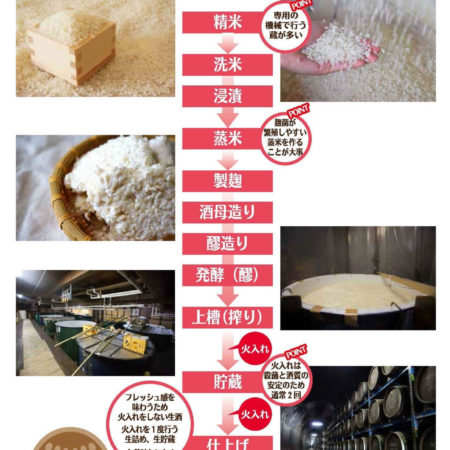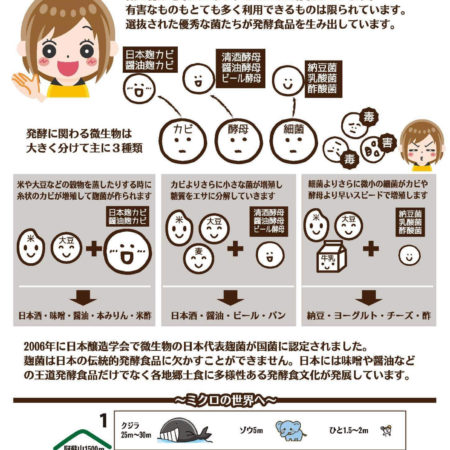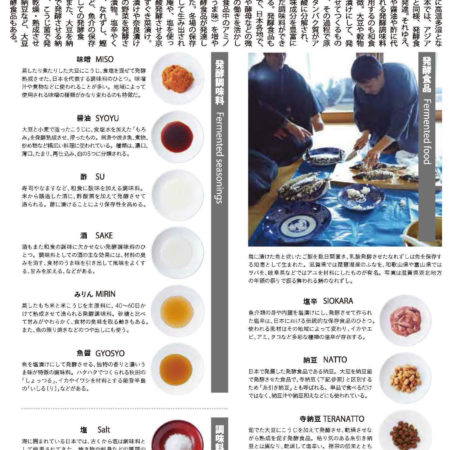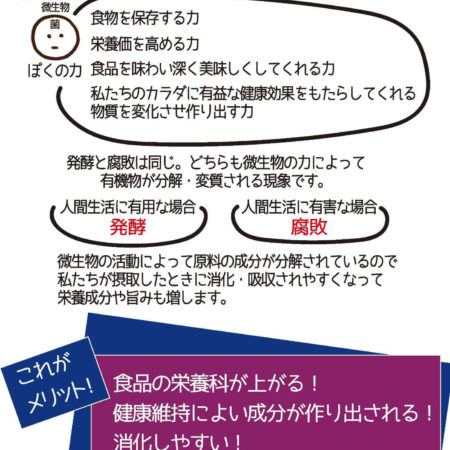SPECIAL
特集
Japan Harvest 2019 Special Panel 食材をおいしく食べる知恵 発酵 Fermentation – the knowledge to preserve and enjoy food.
Japan Harvest 2019 Special Panel
English translation below
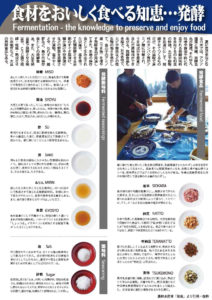
Fermentation – the knowledge to preserve and enjoy food
In Japan, where the climate is hot and humid in summer, fermented foods developed just like in other countries in Asia. Therefore, fermented seasonings, such as miso and soy sauce vinegar, are frequently used for washoku. Most of them are made by fermenting salted soy bean and grains. In the course of preparation, the protein contained in the ingredients is degraded into amino acid, and changes into seasonings containing abundant umami components. There are also various types of fermented foods. Fermented foods, which utilize the activities of microbes such as molds and yeasts to increase the amino acid (umami) contained in food, have developed in different regions in Japan. Takuan pickles were invented as a preservation food for winter. There are other types of pickles made by fermenting vegetables, such as sugukina-zuke of Kyoto which is made through lactic acid fermentation using salt, nukazuke, a type of pickles using rice bran, and narazuke, which uses sake lees. Fermented food is also made with seafood to improve storage life, such as shiokara, kusaya, narezushi and katsuobushi. There are also soy bean fermented foods, such as natto, made by fermenting soy bean with hay bacillus, and tera-natto, made by fermenting soy bean with koji molds and maturing after drying.
Farmented seasonings
Miso -Miso is one of the representative seasonings of Japan, made by fermenting and maturing steamed or boiled soy bean by adding koji and salt. It is often used for miso soup and stewed dishes. It is also characteristic that the type of miso varies largely among regions.
Soy sauce – SYOYU is made by fermenting, maturing and pressing “moromi,” which is koji made with soy bean and wheat diluted with salt water. It is used for a wide variety of dishes including sashimi, grilled fish, stewed dishes and pan-fried dishes. Soy sauce is divided into five groups: koikuchi (dark), usukuchi (light), tamari (rich), sai-shikomi (twice-brewed) and shiro (white).
Vinegar – Vinegar is a seasoning to add sourness in washoku dishes like sushi and namasu. It is made by adding acetic acid bacteria to sake brewed from rice. The preserving property of food is improved by dipping into vinegar.
Sake – Sake is also one of the essential seasonings for washoku. The major effects of sake as seasonings include killing the smell of ingredients, bringing out the umami of foodstuff and improving the flavor, and adding sweetness.
Mirin (Sweet rice wine) – Mirin is a fermented seasoning made with steamed glutinous rice and rice malt, and by maturing for 40 to 60 days. Compared to sugar, its sweetness is softer, and it also has the effect of killing the smell of foodstuff. It is also used to make the surface of food glossy for dishes such as fish teriyaki.
Fish sauce – Gyosho, having a unique odor and strong umami, is made by fermenting salted fish. Shottsuru of Akita, made with Sailfin sandfish, and ishiru (or ishiri) of Noto Peninsula, made with squid and sardine, are well-known.
Non-farmented seasonings
Salt – Salt has been used widely as a seasoning from ancient times in Japan, which is surrounded by the sea. Not only for seasoning dishes like grilled dishes and sashimi, it is also utilized for preserving foods, such as pickles and dried fish.
Sugar – Sugar is one of the essential seasonings for modern washoku, which includes many dishes focusing on sweetness compared to the cuisines of other parts of the world. However, it is rarely used solely, but by combining with soy sauce, salt and miso in various dishes including stewed dish.
Farmented food
Shiokara- Shiokara is made by salting fish meat and guts and fermenting. It is one of the traditional preserved foods in Japan. Ingredients vary by region, so there are various types of shiokara including squid, shrimp, ami (mysidacea) and octopus.
Natto – Natto is a fermented food developed in Japan. It is a food made by fermenting soy bean with hay bacillus, and is sometimes referred to as “itohikinatto (stringy natto)” in order to distinguish it from tera-natto (below). It is not only eaten as-is, but also is used as ingredients for soup or dressing.
Tera-natto This is a fermented food made by adding koji molds to boiled soy bean for fermentation and maturing while being dried. Unlike stringy itohikinatto, tera-natto is dry and salty. It is said that the food arrived from the continent together with the propagation of the Zen school, and is called tera (temple)-natto because it was often made in temples
Pickles – Pickles are made by pickling food materials in salt, vinegar, sake lees, soy sauce, etc. and maturing. It was invented as a way to preserve vegetables for a long time, such as takuan pickles (pickled daikon radish), pickled ume (Japanese plum) and nozawana (a leafy vegetable)-pickles. It is also characteristic that there is wide variety of original pickles in every region of Japan.
Exempt from MAFF Wasyoku
